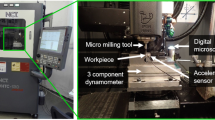Abstract
In this paper the results of an experimental investigation to analyze the machinability of a hardened, carbide-rich cold-work tool steel 1.2379 (approx. 62 HRC) with coated micro end-milling cutters are discussed. Fundamental experiments were performed to determine a cutting-parameter set, which enables an economic manufacturing of dies by 3-axis micromilling with commercially available cemented-carbide tools. The evaluation of the applicability of different tool types is conducted by analyzing the process forces, the tool wear, the surface quality, the material removal rate, and the entire chip volume. Design of experiments was used to significantly reduce the number of experiments and to model the active and passive forces. Concerning the design of tools for the micromilling of such difficult-to-machine materials, it is shown that cemented-carbide tools with robust cutting edges are applicable for this kind of machining. Furthermore, test microstructures were manufactured with the intention of validating the determined cutting-parameter set in combination with the selected tool types. In addition, the dimension and shape accuracy of the microstructures are analyzed.











Similar content being viewed by others
References
Klocke F, Bergs T, Veselovac D, Arntz K, Quito FJ, Kratz S (2007) Von der Makro-zur Mikrowelt. Herausforderung für den Mikroformenbau. Wt Werkstattstechnik 97(11/12):842–846 (online)
Klocke F, Arntz K, von Bodenhausen J (2004) Potenzial beim Hartfräsen von Mikrostrukturen. Mikroproduktion (1):24–26
Fleischer J, Löhe D, Kotschenreuther J, Schulze V, Deuchert M, Halvadjiysk G, Haupt S, Kienzler A (2007) Fertigungsverfahren in der Mikrotechnik. Oberflächenqualität und Miniaturiserungspotenzial von Mikroformeinsätzen. Wt Werkstattstechnik 97(11/12):847-851 (online)
Aramcharoen A, Mativenga PT (2009) Size effect and tool geometry in micromilling of tool steel. Precis Eng 33(4):402–407
Aramcharoen A, Mativenga PT, Yang S, Cooke kE, Teer DG (2008) Evaluation and selection of hard coatings for micro milling of hardened tool steel. Int J Mach Tools Manuf 48(11/12):1578–1584
Eichenhüller B, Engel U, Geiger M (2010) Microforming and investigation of parameter interactions. Prod Eng Res Dev 4(2/3):135–140
Sieben B, Wagner T, Biermann D (2010) Empirical modeling of hard turning of AISI 6150 steel using design and analysis of computer experiments. Prod Eng Res Dev 4(2/3):115–125
Denkena B, Boehnke D, Meyer R (2008) Reduction of wear induced surface zone effects during hard turning by means of new tool geometries. Prod Eng Res Dev 2(2):123–132
Klocke F, Brinksmeier E, Weinert K (2005) Capability profile of hard cutting and grinding processes. CIRP Ann Manuf Technol 54(2):22–45
Suzuki H, Kimura T, Yamamoto Y, Moriwaki T, Okino T, Hijikata Y, Goto I, Goto T, Ono T, Goto Y, Isono H, Takahashi N (2005) Micro milling of hard material with micro milling tool. In: Proceedings of the 5th international conference of the EUSPEN, 8–11 May 2005, Montpellier, France, pp 577–580
Arntz K, Quito EF (2007) Hartfräsen von Mikrostrukturen—zukunftsweisend für den Präzisionsformenbau. Der Stahlformenbauer (6):124–126
Li P, Hoogstrate AM, Oosterling JAJ, Langen HH, Munnig Schmidt R (2008) Experimental validation of micro endmill design for hard milling application. In: Proceedings of the 3rd international CIRP high performance cutting conference. 12–13 June 2008, Dublin, pp 69–78
Kahnis P (2008) Analyse von Größeneinflüssen bei der Herabskalierung des Fräsprozesses in den Mikrobereich. Dissertation, Technische Universität Dortmund
Hüntrup V (2000) Untersuchungen zur Mikrostrukturierbarkeit von Stählen durch das Fertigungsverfahren Fräsen. Dissertation, Universität Karlsruhe
Schauer K (2006) Entwicklung von Hartmetallwerkzeugen für die Mikrozerspanung mit definierter Schneide. Dissertation, Technische Universität Berlin
Biermann D, Kahnis P (2010) Mikrofräsen filigraner Strukturen in Formeinsätzen. MM Maschinenmarkt (5):36–40
Acknowledgments
This artice is based on investigatons of the research project B2 “Machining of molds with filigree structures for sheet-bulk metal forming”, which is kindly supported by the German Research Foundation (DFG) within the SFB/TR 73.
Author information
Authors and Affiliations
Corresponding author
Rights and permissions
About this article
Cite this article
Biermann, D., Baschin, A., Krebs, E. et al. Manufacturing of dies from hardened tool steels by 3-axis micromilling. Prod. Eng. Res. Devel. 5, 209–217 (2011). https://doi.org/10.1007/s11740-010-0293-7
Received:
Accepted:
Published:
Issue Date:
DOI: https://doi.org/10.1007/s11740-010-0293-7




